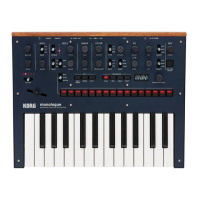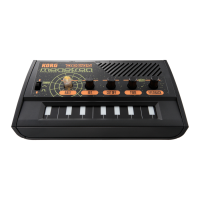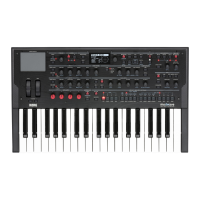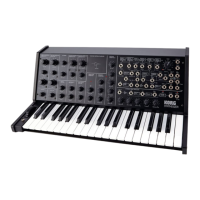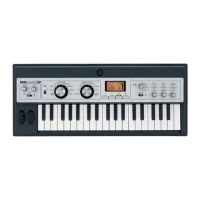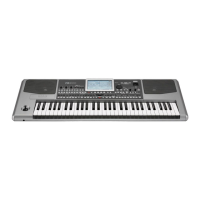A*
shown
above, auto
damp told* alt
the notes *o
a
chord,
as
long as any
one
of the keys
<s
kept depressed if
the
envelope generator release time *s
greater
than
0,
this lets
you
release the
entire
chorrj when you release the last key used
Wie dw
Abbildung
zeigt.
halt AUTO
DAMP
alte Noten elAes
Akkordes. soUnr^e
erne dec
angeschiaQencn Tastcn gedruckt
rjrhalten wird
8ei eioer
Hullkurvengene-
rjtgr*R6L6ASE ZeivEinsteflungvonuber
ha1 man so die
Mogl»chkeit, den
gesamten Akkord durch NiederhaUen nur
cioer
der
fasten
/u
halted und dann
durch Freigeben auchdieser letzten Taste
Oufcuh
'.>."'
Comme indtqud dans if* tableau
(k>
sus.
larnortissement
au
cornet
i quo
permit rje tenir
toutes
les notes
en
accord aussr lonQtemps
que
rune
ties
notes
est jouee et
mamtenue presage
Si
la duree
dex
unction
du
g£rie*;neur
den-
vetopoe
est
suprjrieure
a 0. ceo voui
permet
de
tare disoaraitre reccord
com*
plet iorsque
U
dermere louche
lOuee est
reiachee
KEY
ASSIGN MODE
The advent of micro-computer tech-
nology has had
a
profound effect on the
relationship of the keyboard
10
the
synthesize/, and allows
a
greater degree of
flexibility and versatility man ever before
pos&ibtrt In the
past,
synthesize'
key-
boards were able to produce one, or
at
best two. notes at one time. Today,
an
integrated circuit
approximately the sue
of a peck of
matches
can
perform
a huge
number of diverse
lasks in a
split
second.
Among other things, the micro-computer
can "scan" an entire keyboard
at
high
speeds, and assign multiple key depres-
sions
to a
limited number of synthesizer
•'voices" leg. 4. 5. 6, 8. etc.! using one or
more predetermined Assign Modes Thts
is
called Channel Assigning
each
key
depression go.ng 10 the next VCO
M
order, creating interesting random-type
effects
when different sounds per VCO
are
used ._
through
use of the
Arpeggia
tor
mode. (See Arpeggiato' section
below.)
The method
used to
assign notes
to
the different VCOs is called "reset" As-
signment, meaning the order of VCOs
sounding is "reset**
to
the beginning
(VCO 11 whenever the player releases all
keys. In effect*
a
one key depression
always goes
to
VCO I
, a
two-note interval
to VCOs 1 and 2.and
so
forth. fSee chart
below. I The player thus has belter con*
trol over which key depression goes to
which VCO
when
using different sounds
per
VCO. Beyond 4 notes
depressed,
the
oldest notes sounding are reassigned
to
the latest notes ptayed, in rotating order.
Thus, the four sounding notes will always
be the four last notes played*
If certain notes are released while one
or
more
aro
held, tho released notes will
either continue 10 sound or will be cut
off,
according
to the setting of the AUTO
DAMP
switch (See
below).
The VCOs'
Assign
LEDs
will
turn off.
however,
regardless of the
AUTO
DAMP setting, in
order
to
indicate whrch
VCOs are
still
being held down.
Dieses witMige Bedienfeid drent fur
Wahi der
Einsai/an des
Mono/Poly
-
ois monophoner
ooer
pofyphoner Synthe
£ft«r.
Cetie
section
est
importantc
ca' cite
vous permet dfl chois*r le mode
dt
fonctionnement
du
synthetiseur
Mono/
Poly: en syntheliseur monophonioue
ou
polypromerne
8
s
re
e
lllll
hAlD v *
«»OL'
KEV ASSIGN MODE
i
1 .
II HOLD
Be»
eingesohaiteter HOLD Taste wtrd.
unabhangig von
mono-
Oder polyphonem
Betrieb. der Klang qehatten.
aNona
Zum Scha'ten aul monophonen Syn*
thesi/erbetneo.
Dabe*
wird der als lettte
angeschfagenen Note Priori
tat
gegeberv
®
CHORD MEMORY
Hier konnen fur potyphonen Betrteb
Akkordsirukturen
eus bis ju
v>er Tonen
eingegeben werden.
Diese
Akkorde
werden dann auf Anschiagen nur etner
Taste reproduiiert. wobet d<e
ange-
schtegene NoseatsGrundtondesAkkordes
verwendet wird
Zum
Spevohern
oer
Akfcordstrukturen
junaotw im
KEY ASSIGN MODE-FeM
auf POLY schaltea Oannden gewOnschten
Akkord anschiagen und. wabrend dieser
erklingt. die CHORD MEMORY-Taste
drucken Als zweite Moglrchkeit kann
auch lunachst auf HOLD gescheltet. dann
der Akkord angeschlagen und die
CHORD MEMORY-Taste gedruckt
werden Nach
dem
Spe*chern
eines
Akkordra stent
oeser.
aufgebaut auf der
II HOLD
Des que
ot
commutateor
est
bascule
sur
sa
position
marche, te son delivre*
est
tenu (quel
oue soi t le mode choisi
1
.
2)
MONK)
Pour
ut
1 liter
ta synthrjtiseur Mono/
Poly en synthetisaur
n^nr^phonique. Ceci
fait empfoi a un systeVne
de
priortt4
de
la demise
iouee.
A CHORD MEMORY
Cec* permet
de
memortser un accord
se composant
de
quetfe notes jouees en
mode polyprionicjue
L
'accord
est
repro-
duit Iorsque
des
touches sont
joueea une
a une en mode mcnophonique
Pour qu'un accord soit retenue en
rrrfmoire,
il fulfil de regtar tout d'abord
le mode d
affectation
de clavier sur
poly.
Ensuite. iouer r*ccord et presser le
bouton
de
memoire
daccord quand fe
son
est
proc'uit Eventueliernent. il
est
possible
de
presser
et de
mamtenir
le
bouton da mrimoire d'accord
et de fOuer
reccord. Ceci permet
de
reproduiro
par
la suite reccord on jouam n*impone
qu
'elle
note.
!«

